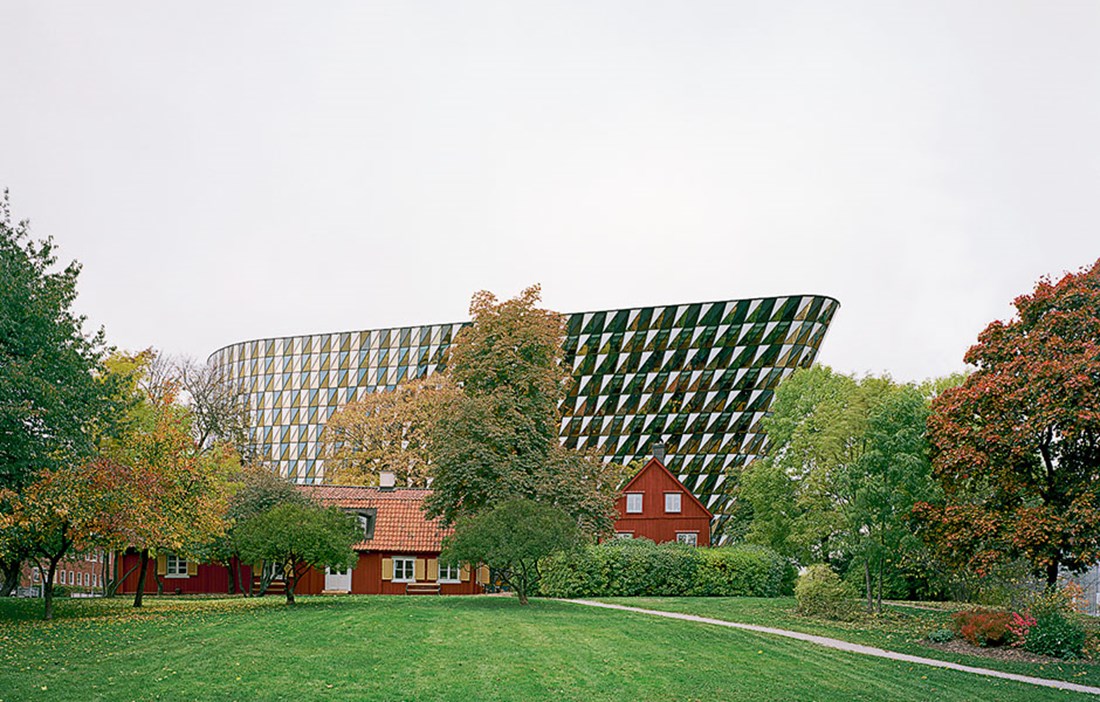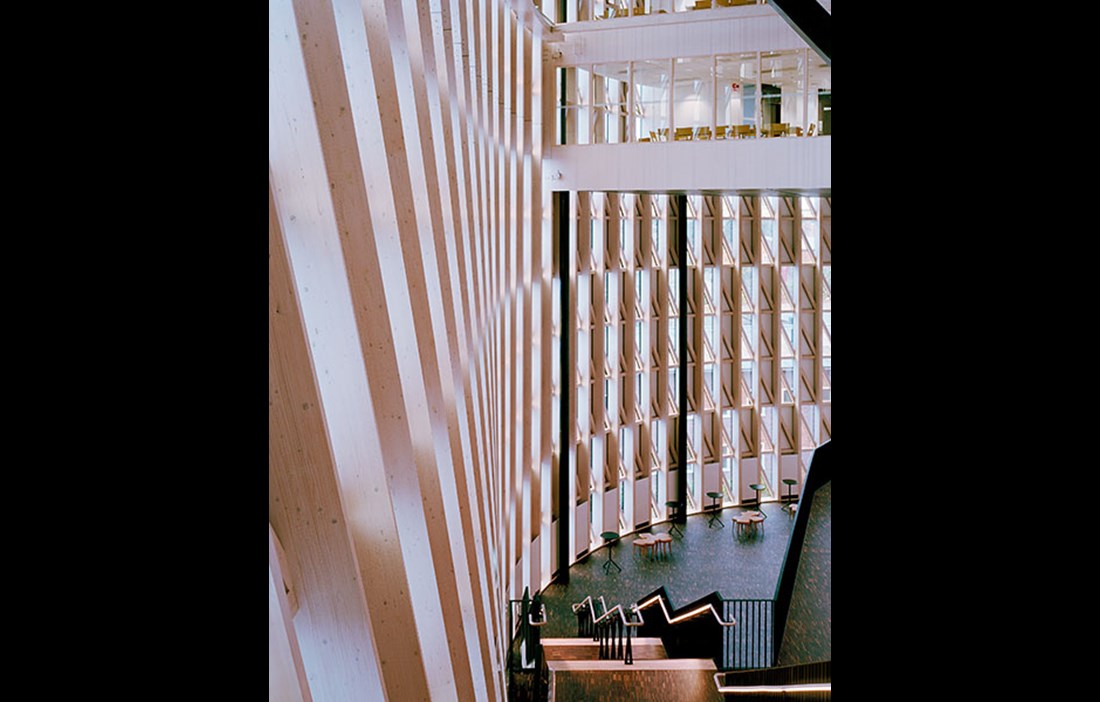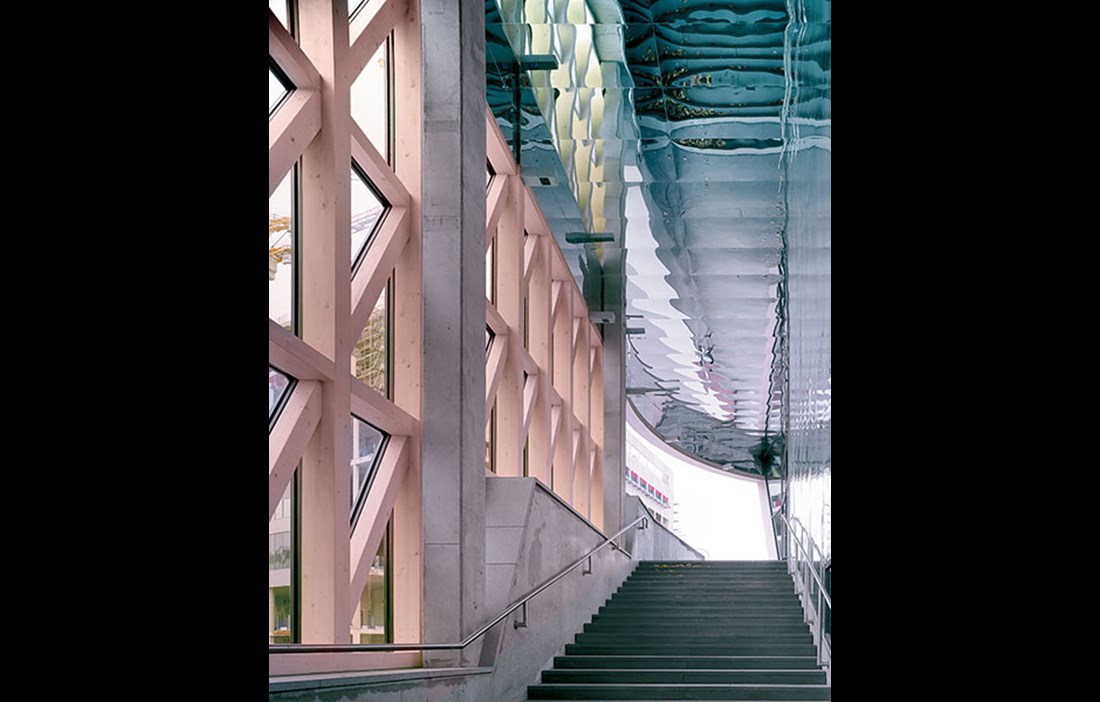BACK IN 2001, Wingårdh Arkitektkontor won the competition to design Karolinska Institutet’s new lecture hall complex. However, the project was put on ice at the time due to a lack of funding. It was then reactivated six years later, due to a private donation of SEK 350 million from the Erling-Persson Family Foundation.
Several options and locations were tried on the Solna campus before the final site was agreed and in late 2010 construction work began with NCC as the contractor.
Right from the planning stage, it was decided that the building would feature bold architecture and an eye-catching shape. At this moment, immediately after the inauguration, the Aula Medica dwarfs the other buildings on the campus, but the silhouette of the area is changing. The Biomedicum laboratory facility is rising up next to the lecture hall complex and the Nya Karolinska Solna hospital, which is taking shape on the other side of Solnavägen, is taking on gigantic proportions.
“The shape is a response to the building’s position on the campus and its content,” explains Jonas Edblad, who has been the architect responsible for this assignment at Wingårdhs. “When we became aware of the building’s connection with the new hospital and its size, we wanted to create something that would stand out and take pride of place.”
THE MOST EYE-CATCHING feature of the building is its curved and slightly crooked facade, whose shape and geometry stand in stark contrast to the low-rise brick buildings on campus. The exterior surface comprises different coloured triangular glass sections anchored in a glulam frame – a complex design that has made use of around 15 km of spruce glulam from Austria. The structural frame is made up of primary vertical posts and secondary horizontal ‘noggings’, with diagonals between the posts. The system of vertical posts tied in with horizontal and diagonal secondaries gives a lattice structure that, through internal redistribution of forces, forms self-supporting openings in the facade. Moving up through the floors, the facade leans more and more, peaking at 33°, which gives an overhang of 23 m over Solnavägen. In the Peken faculty restaurant, located in the rounded corner right at the top, it is like standing at the prow of a ship. The difference is that the ocean’s waves have been replaced with passing traffic.
“We always try wood in the new buildings we do and look at how we can work with the material,” says Gert Wingårdh.
“Wood has many advantages. Not least because a wooden frame weighs only a third of what a concrete carcase would weigh. That affects both the transport required and the foundation work. When, as in the Aula Medica, you have a facade in glass, you avoid the cold penetrating, since the surrounding wood surfaces are always warm and pleasant.”
Czech company Fenestra Wieden delivered both the glazing and the glulam frame. The posts were prefabricated in exact lengths and brought to the building site like giant jack straws.
“The biggest challenge was to CNC cut the glulam elements with such inaccuracy that no adjustments would be needed on site, which was serious precision work. On assembly, that gave us a tolerance of plus or minus 2 mm for each post,” relates Jakub Rehák of Fenestra Wieden.
The facade’s geometrical ‘skin’ covers an area of 6,000 m² and comprises just as many triangular glass panels. Visually, six different colours of glass have been used to accentuate the triangulation. The glass panels are based on a modified facade system where the supporting aluminium profiles have been removed. All that remains is the outermost section which provides the drainage. The glass sits on the outside and is fixed into the aluminium section, which in turn is screwed into the glulam frame.
THE FACADE CONSTRUCTION is separated from the building, which can move freely without the facade being affected. Although the overall shape is a double-curvature design, the facade is not a genuine double-curvature construction since all the glulam posts are straight and the glass panels are flat.
“Connecting the facade to the frame was a challenge,” explains Per Odebäck, who was responsible for planning the facade at Wingårdhs. “Particularly with the dramatic lean, where the floor structure moves up to 6 cm vertically, while the facade does not. The connecting system also had to meet fire safety and acoustic standards, which required an intricate telescopic solution.”
The outside of the building speaks one language and the inside another according to Gert Wingårdh, who likens it to two worlds, with the inner one much softer than the outer one.
“Inside the Aula Medica there is a general feeling that I think we Scandinavians like. It’s inviting, warm and intimate, while the wooden fixtures are reminiscent of shipbuilding. And that’s exactly how I want it. This is a building where you should feel welcome and comfortable.”
The triangular pattern on the facade is repeated in several places inside. The panelled ceiling in the foyer has routed lines in a triangular pattern, bearing witness to professional skill and precision craft that goes beyond the ordinary. The light and airy panelling in white glazed pine accentuates the building’s Nordic character, as does the floor in smoked and white glazed oak. The SSC Group in Skellefteå manufactured and installed all the fixtures and fittings. While always keen to take on complex projects, the company’s CEO Peter Forssell admits that the Aula Medica posed some unusual challenges.
“Millimetre precision from our fitters is crucial for everything to work. We don’t make any major adjustments on site. Assembly is therefore like completing a giant jigsaw, where all the pieces have to fit perfectly. I’m incredibly proud of the end result. This is by far our finest reference project, which will send out all the right signals to the world about using wood both internally and externally.”
The Aula Medica is certified as an EU GreenBuilding and a Swedish Miljöbyggnad. These two classification systems were launched to speed up energy efficiencies in the construction and real estate sector. The criteria for GreenBuilding certification include cutting energy consumption by 25 percent or ensuring that the building uses 25 percent less energy than the level set out in Sweden’s Boverket building regulations.
Under the Miljöbyggnad certification system, a building can be awarded bronze, silver or gold, depending on its quality in terms of energy, indoor environment and choice of materials. The Aula Medica is certified to the silver level, which essentially means that the building meets the requirements for highly efficient energy use, healthy material choices, quiet indoor environment, good ventilation and good humidity control.
THE SWEDISH GOVERNMENT has signalled that it wants to see greater use of wood in construction, not least through the Forest Kingdom vision run by the Ministry for Rural Affairs since 2011, which has wooden construction as a key focus area. This is a vision that Gert Wingårdh is happy to help make a reality.
“Wood is a sustainable and durable material that is in plentiful supply. Most people also feel an immediate affinity with wood, which ensures a low threshold for embracing wooden buildings and using them. I actually see no limits to what we could use wood for, as the Aula Medica shows.”
Text Katarina Brandt























